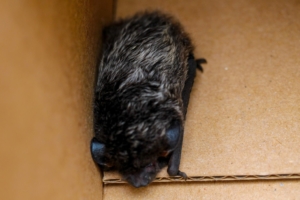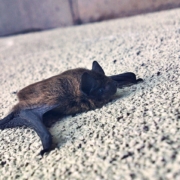Can Bats Get Stuck In Walls?
As a matter of fact, bats can and sometimes do get stuck in walls. Homeowners often experience such a situation when one or more bats get stuck in their home, and particularly in their house walls. This wildlife will become stuck in the wall void when it is trying to fly into a tight space and cannot find a way out, it might be very young, or it is sick or just not strong enough to fly out of the crevice.
If you don’t get rid of it while it’s still alive, the trapped bat will starve and die in the crawlspace wall. The odor of its rotting body will in turn attract various pests such as rodents and insects.
Keep reading as we explain in more detail whether bats can get stuck in walls and why they do!
Can Bats Nest In The Wall?
Bats can find many, even the most unimaginable for you places to roost in your home. These animals are small and able to squeeze through tiny cracks and crevices.
Being nocturnal creatures, bats don’t like light, so your attic is a perfect hideout for them. After entering the house, they might sometimes roost in the walls or keep crawling until they find more room in the attic.
However, if the entry holes to your attic are sealed tightly to prevent bats and other wildlife from accessing it freely, they will nest in the wall void, instead of in the attic. This is common mostly with the smaller bat species that want to roost in a space that is snug.
It can sometimes be difficult to tell by appearance how small a roosting space is. Obviously, it has to be larger than the bat itself but cannot be smaller than a couple of inches for the bat to nest and stay comfortable.
Some bats can also hibernate in house walls during cold winters if there is a suitable spot for them in the void. But preferably, they will look for an attic to hibernate in. You will notice bat droppings on the floor near the place where they exit your home in the spring.
How Do Bats Get Into Walls?
Bats usually enter from the outside in search of a site to roost. These mammals can locate gaps around the roof and squeeze through them to make their way into the house. It is common for them to push their bodies through a hole that’s as narrow as a dime!
If there are no trees or other suitable roosting spots nearby, they might look for a place in your home. They like to roost in dry, dark, secluded spaces that are not too cramped.
Also, they need to be able to escape predators, so they prefer high ceilings and places where they can go all the way up to find shelter. This way they may end up in the crawlspace or the void of your wall.

Can A Bat Chew Through A Wall?
Typically, bats don’t chew through walls or any other building materials the same way that rodents would do. Even though some bat species have very strong teeth, they are not for chewing through walls or any materials, but they are for breaking up and gnawing on the hard shells of insects like beetles.
Most of the time, bats will be able to escape if the opening is big enough for them to squeeze through. Bats that do get stuck in the wall trying to find their way out will cause a lot of damage, mainly because of their corrosive waste.
How Long Will A Trapped Bat Survive In The Wall?
This is hard to say as it depends on the size of the bat and where exactly it is stuck. The bats in your walls will be fine until they eventually run out of energy. Something that’s small might be able to survive for a couple of days before it can find a gap to squeeze through. A larger bat might survive for up to a week in a space that is too small for it to get out of on its own.
However, this all depends on whether the animal has access to food and water. A trapped bat will die within 24 hours if it doesn’t drink or eat during this time.
How To Know If There’s A Bat Stuck In Your Wall
If you think you have a bat trapped in your wall, listen carefully. The bats will start fluttering around when they become stuck in a space. They will be desperate to find a way out, so they’ll be flying around the crawlspace or wall void, trying to find a gap or crevice they can get through.
Also, if you hear squeaking or scratching sounds coming from the inside of your wall, you can be almost sure that there is a trapped bat.
But if you hear the bat flapping frantically, there’s probably no point in trying to rescue it because it has already given up hope of escaping. If there’s something wrong with the bat, it might be sick or weak and not able to fly.
Therefore, it’s best to contact a wildlife control specialist right away if you notice any unusual noises in the wall.
A bat can usually escape from inside of the wall on its own and won’t be stuck for too long, sometimes only a couple of hours. Even if you don’t see the bat, you might notice droppings on your floor after it escapes.
If the bat has escaped from the wall void and then comes back to roost in the same spot, you might need professional help getting it out permanently.
Pest Control Authority Wildlife is an expert wildlife removal and control company, serving the Carolinas. Our experienced technicians specialize in the safe, humane, and permanent removal of bats from the house. Call us today and let us solve all your bat problems for good!





